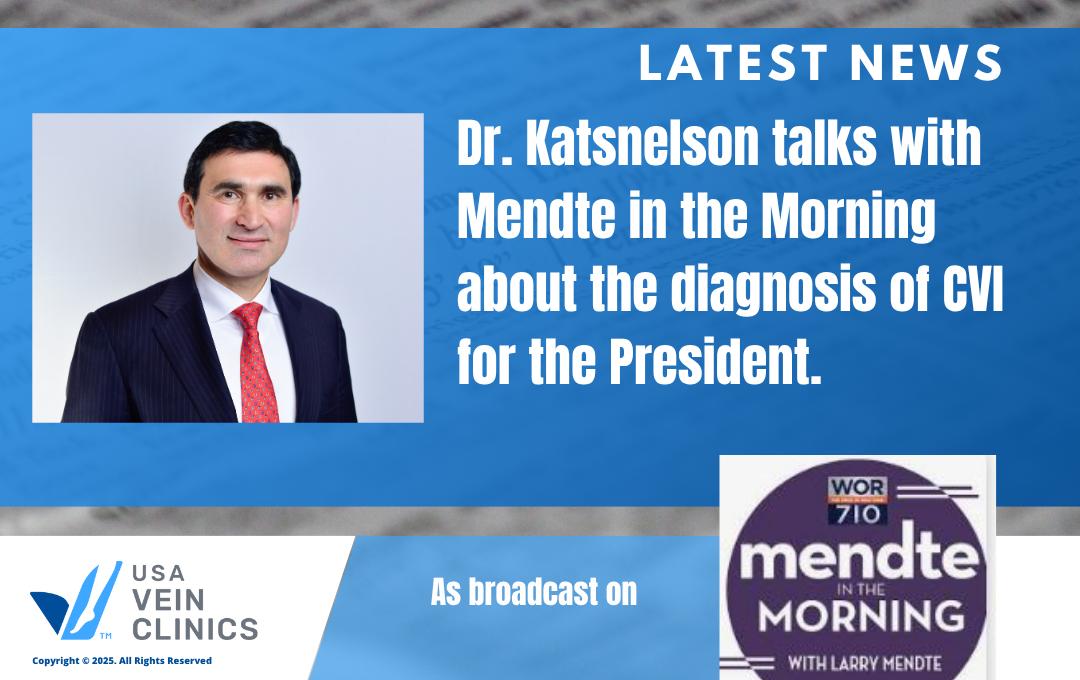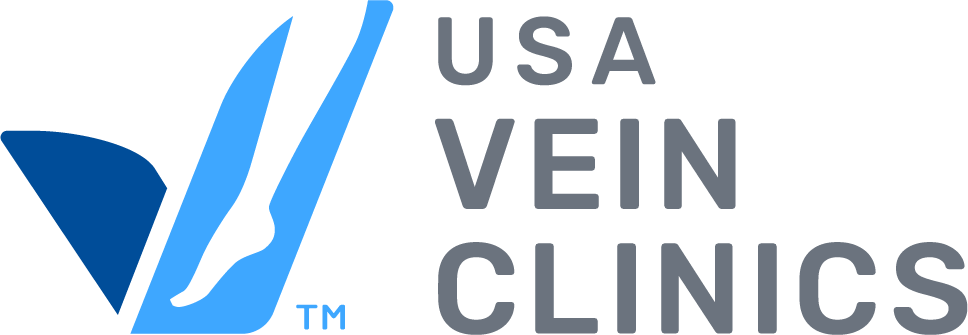
So, just what is chronic venous insufficiency, the vein condition President Trump was diagnosed with this week?
Dr. Yan Katsnelson talks with Mendte in the Morning about the diagnosis of chronic venous insufficiency for Donald Trump and what that means for the President.
Listen to the radio program here:
Transcript: Dr. Yan Katsnelson on CVI After Trump Diagnosis
Speaker 1 (Larry Mendte) (00:00): Well, one of the big stories today is, of course, the vein affliction that Donald Trump suffered from. He had to be treated by doctors. They’re saying it’s going to be around for a long time. And luckily we have one of the preeminent voices in the world, one of the preeminent doctors in the world when it comes to vein afflictions, Dr. Yan Katsnelson, founder and CEO of USA Vein Clinics. By the way, they have over 160 locations, 40 in New York City alone. They’ve been around for 20 years, and of course, Dr. Katsnelson is considered one of the experts on this in the world. Uh, Doctor, thanks so much for spending some time with us today on this.
Speaker 2 (Dr. Yan Katsnelson) (00:45): Thank you for calling me.
Speaker 1 (Larry Mendte) (00:47): Absolutely. Let’s, let’s start out with what he has and maybe you can explain it to me.
Speaker 2 (Dr. Yan Katsnelson) (00:57): So, President Trump has a very common condition called superficial venous insufficiency. About 30% of adults at this age suffer from this condition, and it’s basically blood congestion that’s caused by broken valves, preventing the return of venous blood towards the heart. And President Trump works very hard, he stands a lot, he travels a lot on a plane, and he’s also not very thin, and it all exacerbates the problem with the legs. It’s very common, easy to diagnose, and I’m glad it’s just a venous insufficiency, not a heart problem, not a kidney problem. And the reason it’s good because it’s easily treatable. The treatments for venous insufficiency, it’s the ablations, with sclerotherapies, and it takes 10 to 15 minutes. They’re actually all covered by insurance, and the science is very well established and after the treatment the swelling, pain, night cramps, all disappear. What’s important to know is if left untreated, it can be a very serious condition, even deadly. Even asymptomatic venous insufficiency could increase risk of DVT more than five times, and more than about 10,000 people in the U.S. die from DVT every year in the United States.
Speaker 1 (Larry Mendte) (02:38): Are you at an airport right now? I hope you don’t miss your flight. Are we holding you up for something?
Speaker 2 (Dr. Yan Katsnelson) (02:44): I’m in an airport. I’m after…
Speaker 1 (Larry Mendte) (02:47): I heard announcements in the background. Well, that’s a little bit frightening that if it’s not treated. So how does someone know if they might have it?
Speaker 2 (Dr. Yan Katsnelson) (02:57): Well, just signs. First of all, it’s because it’s very common. You can almost self-diagnose. If someone has bulging veins, big ropey varicose veins, swollen legs, discoloration, brownish-red discoloration, thick skin, night cramps, 99% it will be veins. Because it’s very, very common, and the perfect diagnosis is just ultrasound. It’s an inexpensive, easy ultrasound, vascular ultrasound. The important thing, it needs to be done in a standing position because we need to check how valves work against the gravity. If ultrasound is done in a lying position, you will not see it. It needs to be in standing, and not every laboratory knows how to do ultrasound in a standing position. Usually just in the places specialized for vein treatments, this study is done. So it’s very important to find clinics, vein treatment clinics, that will help with this, and then we can identify exactly which veins have a broken valve and we can do the treatment, basically close those segments and redirect the blood flow into the right veins instead of the wrong veins. That’s, and it’s done, and they will just sound guidance under where exactly we’re doing, and then the result and outcome and improvement is extraordinary and immediate.
Speaker 1 (Larry Mendte) (04:26): Great, well you keep saying it’s treatable. Is it curable?
Speaker 2 (Dr. Yan Katsnelson) (04:30): Yes, yes, it’s curable. So these veins, it’s a mechanical problem. We fix this mechanical problem. Think like a flood in the basement. You have a main pump and some pump, and if valves between those pumps pipes are broken, whatever goes up falls down. So we fix the problem with the broken valve, and some pump just takes the water up and the flood stops. Exactly the same thing happens with the veins when we remove these segments that take blood in the wrong, opposite direction, and everything goes in the right direction. Everything stops. No more swelling, no more pain. Because veins, you know, bad circulation creates two types of problems: it’s congestion and poor nutrition. Poor nutrition leads to pain, congestion to swelling, and because of stagnation, think like a pond instead of a river, you have this DVT, you know, deep vein thrombosis because blood flow is sluggish and thrombosis can happen. That’s the problem and the biggest problem with the condition.
Speaker 1 (Larry Mendte) (05:43): And I would imagine your recommendation would be if anyone thinks that they may have this, have any of the symptoms that you talked about a moment ago, they get right in to see a doctor, right? And go to one of the USA Vein Clinics.
Speaker 2 (Dr. Yan Katsnelson) (06:01): We try to see most of the patients within two, three days because we have so many locations, we have almost 170 locations across 30 states, more than 40 in New York alone. We work seven days a week, long hours, just try to make sure that people have access to care. And then if left untreated, in many situations, disease progresses towards ulcers, wounds. Between 1 to 2% of Medicare patients have open wounds from vein disease, which is terrible, completely preventable, and completely treatable. So I think, hopefully, I’m sure President Trump will be fine and he will get appropriate treatment, and hopefully many, many thousands of listeners will pay attention and help themselves by simply calling and seeking treatment that will be very successful.
Speaker 1 (Larry Mendte) (06:58): No doubt, right? There’s always some good that comes out of this, and people get to learn a lot, and I think a lot of people that didn’t know what you just told them know now. Thank you so much for being with us, Dr. Yan.
Speaker 2 (Dr. Yan Katsnelson) (07:08): Go ahead, and I can only comment that President Trump is doing an extraordinary thing, providing transparency and shedding light on health issues that no other president has ever done before. So that’s, that’s a very good trend.
Speaker 1 (Larry Mendte) (07:27): Yeah, very well said. Yeah, that’s, that’s exactly right. Most hid them, and he didn’t. He came right out and said this, and he might save a lot of people. Dr. Yan Katsnelson, founder and CEO of USA Vein Clinics, over 160 locations. You’ve got 40 right here in New York alone, and they’ve been around for 20 years. By the way, you can learn more about it and maybe you can get an appointment if you need to at USAVeinClinics.com. Doctor, thanks so much for your time.
